Papers by Charlotte Stern
Organometallics, 1999
The cyclohexadienyl ring is an example of the open metallocene ligand family. 7 Open and hal... more The cyclohexadienyl ring is an example of the open metallocene ligand family. 7 Open and half-open metallocenes have been prepared and studied for a wide range of transition metals, lanthanides, and actinides. 7 The acyclic dienyl ligands (pentadienyls) tend to ...
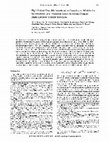
Journal of the American Chemical Society, 1995
trans-Dioxorhenium(V) tetrapyridyl species are currently under active investigation as model syst... more trans-Dioxorhenium(V) tetrapyridyl species are currently under active investigation as model systems for interfacial two-electron, two-proton transfer reaction sequences (Jones-Skeens et al. Znorg. Chem. 1992, 31, 3879). We now find that the corresponding oxo, methoxo complexes can be prepared from the dioxo species and methyl trifluoromethanesulfonate. The new complexes behave nearly identically with the analogous oxo, hydroxo complexes-with one important exception: CH3+, unlike H+, does not dissociate from the oxo ligand. As a direct consequence, the usually elusive rhenium oxidation state IV is stabilized with respect to redox disproportionation and is observable for several complexes at high pH. The ability to detect this state, in tum leads to (1) direct access to the formal reduction potentials for the isolated le-redox couples comprising the overall two-electron transfer (key information for understanding multi-electron transfer kinetics), (2) elucidation of the profound structural and energetic consequences of the initial protonation (methylation) step in the dioxorhenium(V) reduction kinetics, (3) estimates for pK, of (0)(HO)ReV1L43+ (exceptionally negative), and (4) estimates for the first pK, of (H0)2Re111L4+ (extremely large and positive). The combination of (1) and (2), in principle, provides sufficient information to characterize completely the energetic accessibility of key intermediate species lying just before or just after the transition state for the two-electron, two-proton reduction of dioxorhenium(V) at electrochemical interfaces.

Inorganica Chimica Acta, 2001
A strongly absorbing and significantly luminescing diimine ligand, N,N%-diphenyl-p-(benzyl-1,3,4-... more A strongly absorbing and significantly luminescing diimine ligand, N,N%-diphenyl-p-(benzyl-1,3,4-oxadiazole)-2,2%-bipyridine (DPO-bpy), incorporating p-conjugated oxadiazole linkage units and remote triphenylamine groups has been synthesized and characterized, as have the corresponding mononuclear metal complexes, fac-(DPO-bpy)Re(CO) 3 Cl and fac-(DPObpy)Mn(CO) 3 Br. The rhenium complex was structurally characterized via X-ray crystallography. The nature of the emitting state of each of the complexes was elucidated via transient DC photoconductivity (TDCP), a technique that reports on the sign and magnitude of the difference in dipole moments between the emissive state and ground state. The TDCP signal is negative for the Re complex and is consistent with emission from a metal-to-ligand charge-transfer state. On the other hand, the TDCP signals for the Mn complex and for the free ligand are positive, with the complex yielding the larger value. The TDCP results, as well as extended Hü ckel calculations, support an intraligand charge-transfer assignment for the emissive states of both the Mn complex and the free ligand, with the former displaying a significantly higher emission quantum yield.
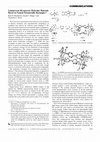
Angewandte Chemie, 2000
There has been tremendous recent interest in the synthesis of discrete inorganic and organometall... more There has been tremendous recent interest in the synthesis of discrete inorganic and organometallic cyclophanes as candidate host species for selective guest binding. [1±7] We have previously reported on tetrametallic square cyclophanes, which function in the solid state as sensors for volatile organic compounds (VOCs) or as molecular sieves, and on other materials which behave as luminescent sensors for anions in solution. [8, 9] Reasoning that a rectangular cavity would offer enhanced binding and selectivity for, for example, planar aromatic guest species, we sought to develop useful transition metal based ªmolecular rectanglesº. [10±12] While the first rectangles we made were either too small to accommodate guests or carried an undesired charge, they did give us insight into a synthetic strategy for the formation of mixed-ligand metallocyclophanes. (The charged compounds are of little value as building blocks for mesoporous materials because counterions block the channels formed by cavities; furthermore, because of their charge, the compounds are slightly water soluble, which precludes their use in aqueous environments.) Using a similar method, we developed a new family of metal-based molecular rectangles, that use a rigid, dianionic bisbenzimidazolate bridgeÐboth to compensate for the cationic metal charge and to provide a cavity wide enough to serve as a host for small, planar, aromatic guest compounds. The molecular rectangles were synthesized according to Scheme 1. The absence of long-chain oligomers, as opposed to macrocycles, was initially indicated by a) 1 H NMR spectroscopy, which showed only well resolved signals for each of the protons, b) FAB mass spectrometry, which showed no significant peaks at higher m/z ratios, and c) its high solubility product in several polar organic solvents (such as THF, CHCl 3 , CH 2 Cl 2 , and acetone, but not in short-chain alcohols, CH 3 CN, and hexanes). Single-crystal X-ray diffraction (XRD) studies of 2 a yielded the ORTEP representation shown in Figure 1. [13] The dimensions of the cavity, as defined by the Mn atoms, are 11.2 Â 5.5. However, the 4,4'-bipyridine (4,4'-bpy) bridges are bowed inward (presumably a packing effect), such that the cavity width at the center is only 3.9. A similar Scheme 1. Synthesis of bisbenzimidazolate-derived molecular rectangles.
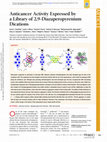
ACS Nano, 2015
Polyaromatic compounds are well-known to intercalate DNA. Numerous anticancer chemotherapeutics h... more Polyaromatic compounds are well-known to intercalate DNA. Numerous anticancer chemotherapeutics have been developed upon the basis of this recognition motif. The compounds have been designed such that they interfere with the role of the topoisomerases, which control the topology of DNA during the cell-division cycle. Although many promising chemotherapeutics have been developed upon the basis of polyaromatic DNA intercalating systems, these candidates did not proceed past clinical trials on account of their dose-limiting toxicity. Herein, we discuss an alternative, water-soluble class of polyaromatic compounds, the 2,9-diazaperopyrenium dications, and report in vitro cell studies for a library of these dications. These investigations reveal that a number of 2,9-diazaperopyrenium dications show similar activities as doxorubicin toward a variety of cancer cell lines. Additionally, we report the solid-state structures of these dications, and we relate their tendency to aggregate in solution to their toxicity profiles. The addition of bulky substituents to these polyaromatic dications decreases their tendency to aggregate in solution. The derivative substituted with 2,6-diisopropylphenyl groups proved to be the most cytotoxic against the majority of the cell lines tested. In the solid state, the 2,6-diisopropylphenyl-functionalized derivative does not undergo π 3 3 3 π stacking, while in aqueous solution, dynamic light scattering reveals that this derivative forms very small (50À100 nm) aggregates, in contrast with the larger ones formed by dications with less bulky substituents. Alteration of the aromaticitiy in the terminal heterocycles of selected dications reveals a drastic change in the toxicity of these polyaromatic species toward specific cell lines.
Journal of the American Chemical Society, 2014

Journal of the American Chemical Society, 2014
A biomimetic, ion-regulated molecular receptor was synthesized via the Weak-Link Approach (WLA). ... more A biomimetic, ion-regulated molecular receptor was synthesized via the Weak-Link Approach (WLA). This structure features both a calix[4]arene moiety which serves as a molecular recognition unit and an activity regulator composed of hemilabile phosphine alkyl thioether ligands (P,S) chelated to a Pt(II) center. The host-guest properties of the ion-regulated receptor were found to be highly dependent upon the coordination of the Pt(II) center, which is controlled through the reversible coordination of small molecule effectors. The environment at the regulatory site dictates the charge and the structural conformation of the entire assembly resulting in three accessible binding configurations: one closed, inactive state and two open, active states. One of the active states, the semiopen state, recognizes a neutral guest molecule, while the other, the fully open state, recognizes a cationic guest molecule. Job plots and (1)H NMR spectroscopy titrations were used to study the formation of these inclusion complexes, the receptor binding modes, and the receptor binding affinities (Ka) in solution. Single crystal X-ray diffraction studies provided insight into the solid-state structures of the receptor when complexed with each guest molecule. The dipole moments and electrostatic potential maps of the structures were generated via DFT calculations at the B97D/LANL2DZ level of theory. Finally, we describe the reversible capture and release of guests by switching the receptor between the closed and semiopen configurations via elemental anion and small molecule effectors.
Science, 2013
Radically Organic Metals such as manganese are relatively stable over a wide range of oxidation s... more Radically Organic Metals such as manganese are relatively stable over a wide range of oxidation states. In contrast, purely organic compounds are rarely susceptible to incremental addition or removal of electrons without accompanying fragmentation or coupling reactions. Barnes et al. (p. 429 ; see the Perspective by Benniston ) report a catenane (a compound comprising interlocked rings) in which the topological structure stabilizes six different states that successively differ by the presence or absence of one or two electrons in the framework. The hepta-oxidized state proved remarkably resilient to oxygen exposure.
Journal of the American Chemical Society, 2005
Journal of the American Chemical Society, 2009
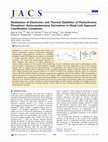
Journal of the American Chemical Society, 2013
A series of d 8 transition-metal (Pt(II) and Pd(II)) coordination complexes incorporating phosphi... more A series of d 8 transition-metal (Pt(II) and Pd(II)) coordination complexes incorporating phosphinefunctionalized aminoazobenzene derivatives as hemilabile phosphino−amine (P,N) ligands were synthesized and studied as model weak-link approach (WLA) photoresponsive constructs. The optical and photochemical properties of these complexes were found to be highly influenced by various tunable parameters in WLA systems, which include type of metal, coordination mode, type of ancillary ligand, solvent, and outer-sphere counteranions. In dichloromethane, reversible chelation and partial displacement of the P,N coordinating moieties allow for toggling between aminoazobenzene-or pseudostilbene-and azobenzene-type derivatives. The reversible switching between electronic states of azobenzene can be controlled through either addition or extraction of chloride counterions and is readily visualized in the separation between π−π* and n−π* bands in the complexes' electronic spectra. In acetonitrile solution, the WLA variables inherent to semiopen complexes have a significant impact on the half-lives of the corresponding cis isomers, allowing one to tune their half-lives from 20 to 21000 s, while maintaining photoisomerization behaviors with visible light. Therefore, one can significantly increase the thermal stability of a cis-aminoazobenzene derivative to the extent that single crystals for X-ray diffraction analysis can be grown for the first time, uncovering an unprecedented edge-to-face arrangement of the phenyl rings in the cis isomer. Overall, the azobenzene-functionalized model complexes shed light on the design parameters relevant for photocontrolled WLA molecular switches, as well as offer new ways of tuning the properties of azobenzene-based, photoresponsive materials.
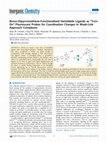
Inorganic Chemistry, 2013
Herein we report a new class of hemilabile ligands with boron-dipyrromethene (Bodipy) fluorophore... more Herein we report a new class of hemilabile ligands with boron-dipyrromethene (Bodipy) fluorophores that, when complexed to Pt(II), can signal changes in coordination mode through changes in their fluorescence. The ligands consist of phosphino-amine or phosphinothioether coordinating moieties linked to the Bodipy's meso carbon via a phenylene spacer. Interestingly, this new class of ligands can be used to signal both ligand displacement and chelation reactions in a fluorescence "turn-on" fashion through the choice of weakly binding heteroatom in the hemilabile moiety, generating up to 10-fold fluorescence intensity increases. The Pt(II) center influences the Bodipy emission efficiency by regulating photoinduced electron transfer between the fluorophore and its meso substituent. The rates at which the excited Bodipy-species generate singlet oxygen upon excitation suggest that the heavy Pt(II) center also influences Bodipy's emission efficiency by affecting intersystem crossing from the Bodipy excited singlet to excited triplet states. This signaling strategy provides a quantitative read-out for changes in coordination mode and potentially will enable the design of new molecular systems for sensing and signal amplification.
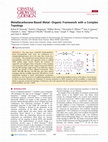
Crystal Growth & Design, 2014
The long, linear cobalt(III) bis(dicarbollide)based bis(isophthalic acid) anion was synthesized a... more The long, linear cobalt(III) bis(dicarbollide)based bis(isophthalic acid) anion was synthesized as a tetraphenylphosphonium salt in five steps from 8-iodo-closo-1,2-C 2 B 10 H 11. The solvothermal reaction between the anionic bis(isophthalic acid) linker and copper(II) nitrate in acidified DMF yielded single crystals. Despite the tendency for copper(II) and analogous linear tetraacids to form members of an isoreticular family of metal−organic frameworks (MOFs) with the fof topology, single-crystal X-ray diffraction analysis revealed the growth of three different frameworks. These MOFs, NU-150, NU-151, and NU-152, have three distinct topologies: fof, sty, and hbk, respectively. NU-152 has a novel quadrinodal topology in which cuboctahedral coordination polyhedra are each connected to 10 neighboring polyhedra via the cobalt bis(dicarbollide) portions of the linkers. The formation of these frameworks illustrates the limitations of structure prediction in MOF chemistry and the possibility of using flexible linkers to generate unexpected topologies. Furthermore, this work represents the first example of the incorporation of an anionic bis(dicarbollide) unit into a MOF.

Chemical Physics, 2000
Electroabsorption or Stark spectroscopy has been used to evaluate the systems (NC) 5 M II ±CN±Ru ... more Electroabsorption or Stark spectroscopy has been used to evaluate the systems (NC) 5 M II ±CN±Ru III (NH 3) 1À 5 and (NC) 5 M II ±CN±Ru III (NH 3) 4 py 1À , where M II Fe II or Ru II. When a pyridine ligand is present in the axial position on the Ru III acceptor, the eective optical electron transfer distance ± as measured by the change in dipole moment, |Dl| ± is increased by more than 35% relative to the ammine substituted counterpart. Comparison of the charge transfer distances to the crystal structure of Na[(CN) 5 Fe±CN±Ru(NH 3) 4 py] Á 6H 2 O reveals that the Stark derived distances are $50% to $90% of the geometric separation of the metal centers. The dierences result in an upward revision in the Hush delocalization parameter, c 2 b , and of the electronic coupling matrix element, H ab , relative to those parameters obtained exclusively from electronic absorption measurements. The revised parameters are compared to those, which are obtained via electrochemical techniques and found to be in only fair agreement. We conclude that the absorption/ electroabsorption analysis likely yields a more reliable set of mixing and coupling parameters.
Angewandte Chemie International Edition, 2010

Acta Crystallographica Section A Foundations and Advances
One of the main missions of the Integrated Molecular Structure Education and Research Center (IMS... more One of the main missions of the Integrated Molecular Structure Education and Research Center (IMSERC) at Northwestern is to educate Northwestern University students and researchers in a variety of analytical instrumentations. IMSERC teaches Crystallography in a variety of ways. Freshman undergraduates get a taste of powder diffraction. Graduate students and Postdoctoral researchers can take a quarter long class that teaches theory, an introduction to data collection, solving and refining crystal structures with various degrees of issues and then writing an Acta paper. Northwestern even hosts the ACA summer course for chemical crystallography every other year. However, the most unique course is an upper level undergraduate course that teaches the synthesis and characterization of Metal-Organic Frameworks and Zeolites. This talk will focus on a unique lab that uses a variety of instrumentation in IMSERC so that the student can get a taste how to evaluate their material.
Journal of the Mexican Chemical Society
The assembly of molecular Borromean Rings from constitutionally independent rings in a stepwise m... more The assembly of molecular Borromean Rings from constitutionally independent rings in a stepwise manner depends on the preparation of robust “ring-in-ring” complexes. The π-electron rich macrocycle bis-1,5-dinaphtho[50]crown-14 (1) is shown to form a donor-acceptor ring-in-ring complex with the π-electron poor cyclophane cyclobis(paraquat-4,4'-biphenylene) (24+) in solution. In the crystal superstructure of [1⊂2]·4PF6, CH···O interactions between the polyether loops of 1 and the bipyridinium units of 24+ could disfavor the threading of dialkylammonium components of a third ring.
Acta Crystallographica Section C Crystal Structure Communications
Di-/.~-hydroxo-bis(dibutylperchloratotin), [Sn(C104)(OH)(C4H9)2], Mr=349.38, monoclinic,
Acta Crystallographica Section C Crystal Structure Communications
... S. BI~LANGER, JT HUPP AND CL STERN 1597. ... Comment Neutral ReI-containing 'mol... more ... S. BI~LANGER, JT HUPP AND CL STERN 1597. ... Comment Neutral ReI-containing 'molecular squares' with the general formula [Re(CO)3(CI)(L)]4, where L is a linear bridging ligand, have been under investigation by our group for some time (Slone et aI., 1996, 1998; Slone & ...
Acta Crystallographica Section C Crystal Structure Communications
ABSTRACT







Uploads
Papers by Charlotte Stern